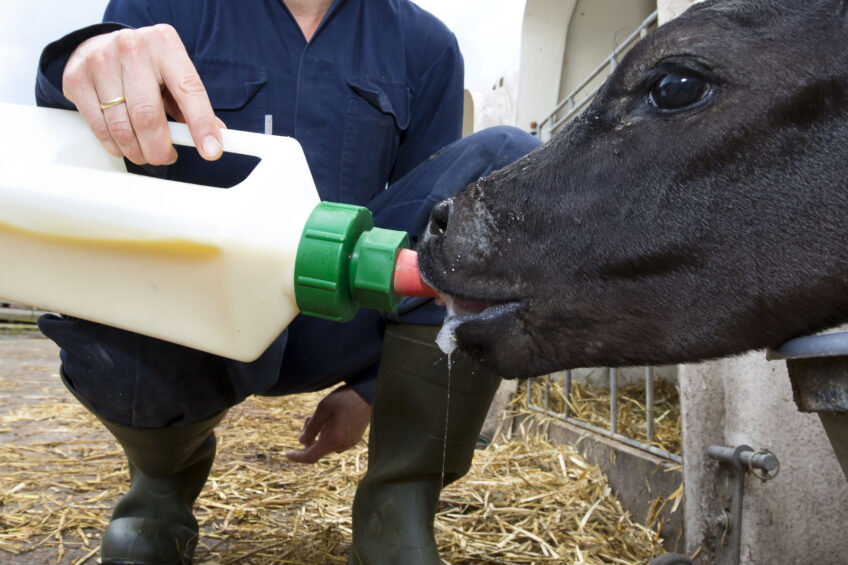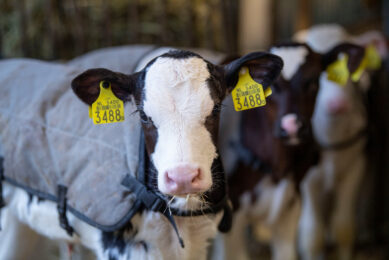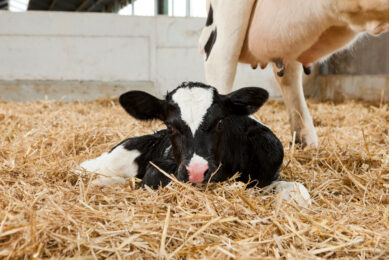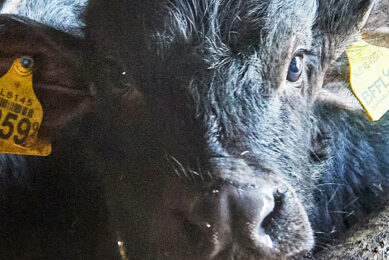Factors affecting colostrum quality and utilisation

What factors determine if newborn calves are getting enough colostrum? This depends on the cow and the quality of the colostrum. This article explains this in more detail.
In the gestating dairy cow, maternal and foetal blood supplies are completely separate; therefore, there is no transfer of across the placenta from the dam to the foetus. As a result, calves are born with minimal immunological defences against environmental pathogens and should thus acquire immunity passively through the consumption of colostrum.
If a calf does not receive an adequate amount of high quality colostrums soon after calving, it may then be subject to an increased risk of morbidity and decreased growth rate and lifetime milk production. The following is an overview of the factors to be considered when attempting to achieve maximum benefits from colostrum and hence improve health and performance of calves.
Colostrum related factors
There are several factors that influence the quality of the colostrum. Firstly, the method of feeding: Leaving calves to nurse from their mothers can cause extreme problems with colostrum and immunoglobulin consumption. Approximately 25-40% of calves that nurse from the dam do not consume an adequate amount of high quality colostrum because calves tend to drink small quantities after birth. This inadequate consumption allows bacteria to enter and multiply in the intestine, causing mortality that may lead to death. Many times, calves do not want to consume the recommended amount of colostrum right after birth because they do not have a strong drive to nurse. Another reason calves might be reluctant could be because the calf might not physically be able to consume colostrum because of the birthing process (internal bruising to the organs or broken bones). When this occurs, esophageal feeders can be used to ensure calves receive an appropriate amount of quality colostrum. It is recommended that calves be removed from their dam no longer than two hours after parturition when fed via bottle or esophageal feeder. Feeding calves with the use of an esophageal feeder or ‘tube’ doesn’t come without risk. Inserting the tube can cause damage to the oral tract of the calf so it should be inserted and taken out very carefully.
Cleanliness
A second factor is the cleanliness. Cleanliness refers to the absence of bacteria in colostrums. Unfortunately, a large percentage of colostrum on commercial farms has high levels of bacteria greater than 100,000 cfu/mL. Bacteria in colostrum have a negative impact on IgG absorption by the calf because they may bind IgG in the calf’s small intestine or they may directly block the uptake of IgG by the intestinal cells. Bacteria in colostrum may also be pathogenic and cause diseases such as diarrhoea. There are several management practices that should be followed to minimise bacterial contamination of colostrum:
- Thoroughly wash your hands before milking the cow.
- Prepare the udder as you would before milking.
- Milk into a clean, sanitised bucket.
- Do not feed colostrum from known infected cows.
- Do not pool raw colostrum.
- Feed calves using clean, sanitised bottles or buckets and nipples.
- Do not let colostrum sitting at room temperature – feed it, refrigerate it (use within 24 hours) or freeze it within one hour of collection.
An effective method for reducing bacterial contamination of colostrum is pasteurisation. Typical milk pasteurisation temperatures are too high for pasteurising colostrum; the IgG is partially destroyed by high temperatures and the colostrum tends to thicken. The recommended practice is to pasteurise colostrum at 60oC for 60 minutes. Pasteurised colostrum stored in a clean, covered container in the refrigerator has a shelf life of 8-10 days. Studies have shown that calves fed pasteurised colostrum have significantly higher serum IgG levels than calves fed non-pasteurised colostrum.
Preservation
Also preservation is key. For many years, the fermented colostrum has been used mainly as a source of nutrients during the first few weeks of life, with little potential value to the immune system. Recent work, however, has shown that the addition of sodium bicarbonate to the fermented colostrum (7.3 g/kg) has enhanced Ig absorption compared to calves fed the unbuffered fermented colostrum. The addition of sodium bicarbonate to the fermented colostrum not only enhances the Ig absorption but also improves the disease-fighting capabilities of the absorbed Ig. This effect could be explained on the basis of the increased pH of the fermented colostrum to a value similar to that of the unfermented colostrum (+ 7.4). At such a high pH value, a bacteriostatic activity could be developed. Thus, lactoferrin (an iron–binding protein occurring naturally in colostrum) will better be able to bind iron, thereby rendering it unavailable for bacterial growth. To this end, the fermented colostrum buffered with sodium bicarbonate should have potential for an effective immunisation of calves in emergency cases when fresh or frozen colostrum is not available.
Cow related factors
There are quite a few cow factors that influence the colostrum. Not surprising, as the colostrum comes from the cow. Firstly, the health of the cow is key. Pathogen exposure is crucial in regards to dam health and colostrum quality. Cows that have been exposed to higher amounts of pathogens are more likely to have higher immunoglobulin levels. Pathogen exposure and age are highly correlated due to the fact that older cows tend to be exposed to a greater number of pathogens. However, there is also a risk in feeding calves raw maternal colostrum because pathogen exposure occurring before calves have developed immunity can affect mortality and morbidity. Mycobacterium avium spp, aratuberculosis, Mycoplasma spp, Escherichia coli, and Salmonella spp are all infectious diseases that can cause scours and septicemia in calves by being shed from the udder or by mishandling and storing raw colostrums.
It is not recommended to feed colostrum that is infected with M. paratuberculosis even if it has been frozen or pasteurised. Because the organism is secreted from the udder, transmission of the disease to the calf will occur. Freezing at very low temperatures or pasteurising at very high temperatures is not reliable for killing the pathogen because colostrum is thicker and denser than milk. It is also suggested that pasteurising is not effective at killing John’s disease because the organism is contained in the white blood cells which makes it harder to reach the organism. Also, pasteurisation does not completely kill the organism but rather reduces the number of organisms present. Commercial pasteurisers also differ from on-farm pasteurisers because of the standards and difference in effectiveness.
Vaccination of the cow
Also vaccination has an effect. Several vaccines are commercially available for prepartum immunisation of cows against rotavirus and coronavirus infections in newborn calves. The pregnant cow is vaccinated starting from 6 weeks before parturition to 2 weeks before the calf is born to stimulate the production of specific types of Ig. These are then transferred to the calf via colostrum to provide an effective means of preventing many diseases which calves are most susceptible to early in their life.
Oral Ig administration to calves at 10 hours of age is another approach to providing immunity against the antigen of interest. This could be accomplished through use of an artificial mixture containing blood serum and colostrum from vaccinated dams. The economic feasibility of providing a concentrated source of specific types of Ig in comparison to other methods for control of infection in calves is subject to question, although it would likely have merit in the event of a severe disease outbreak.
The above approaches are more biologically effective for calves raised on the same farm and exposed to the same infectious agents as their dams. These calves would usually have good protection against diseases prevailing on that farm through which the relevant Ig types have been developed in the dam’s serum and colostrum. Purchased calves and calves that are born to cows recently purchased or brought in from another farm would, on the other hand, have a lesser chance of acquiring immunity to diseases or infectious agents present in and around the calf’s raising barn.
Parity
On average, first-lactation heifers produce lower yields of colostrum and lower Ig concentration in colostrum than cows in their second or greater lactation (Table 1). Colostral quality continues to increase with parity after the second calving, and older cows generally have the best quality colostrum. However, some heifers produce very good quality colostrum and producers should not automatically discard heifer colostrum but should test and keep high quality colostrum from a cow of any parity.
Length of the dry period
Shortening the dry period to 28-40 days does not seem to have a substantial impact on colostrum quality in multiparous cows, although the volume of colostrum produced may be less in cows with a dry period <40 days. cows seem to need at least a 3-4 week dry period to produce good quality colostrum, and when dry period is very short (><21 days) or there is no dry period, colostrum will often be of poor quality. producers should probably not feed colostrum from cows with a very short (><3 week) dry period even if it has>50 g/L IgG, as there will have been inadequate time for proper response to dry period vaccines and transfer of those specific antibodies to colostrum.
Cow nutrition in the dry period
A study was conducted to examine the effect of the energy level of diets fed to dry cows on immunity status and performance of the calves born to these cows. The cows were fed 7 weeks of the dry period (far-off period) and 1 week later (close-up period) on diets containing an energy value of either 0.69 or 0.61 UFL/Kg DM. With a high energy diet, calves had better immunity status attributed to the maternal colostrum which was better synthesised with the higher energy supply of the dam during the far-off period. As a result, the calves had greater levels of serum Ig and IGF-1 and better gains during their first few weeks of life (Table 2). The increased level of serum IGF-1 may also be an indication of better health and lower mortality in the calves born to cows on a high-energy diet during the dry period. It was found that each 1 ng/m increase in IGF-1 will improve the health and reduce the mortality risk through 6 months of age, mainly due to the role of IGF-1 on enhancing the immune function, maintaining the lymphocytic activity, and increasing nutrient availability.
Thermal stress
There are very few reports available to date on the effects of high temperatures on colostrum utilisation by calves. In one study, there was no significant difference in serum Ig between calves kept at normothermic temperature (20oC) and those kept at 38oC. Cold stress, on the other hand, has negative effects on the absorptive function by the intestine, and hence on the concentration of all classes of colostral Ig in the serum of the hypothermic calves kept at 1oC.
Cold stress may also have an indirect effect on the acquisition of protective quantities of colostral Ig exemplified by the degraded clinical condition of the animals, including their ability to rise and stand and their willingness to nurse. Thus, it is possible for cold-stressed calves to have normal capabilities of intestinal absorption, yet remain hypo-globulinemic because of cold-induced physical weakness and failure to nurse.
References are available from the author upon request.
Join 13,000+ subscribers
Subscribe to our newsletter to stay updated about all the need-to-know content in the dairy sector, two times a week.











